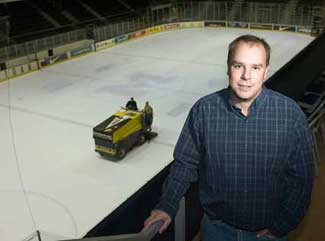When the 2003 blackout hit Michigan and the northeast, people were advised to keep their refrigerators closed to avoid letting out the cold air. But what do you do when your refrigerator contains an 85-by-200-foot ice rink that must be kept at 20 degrees or colder?

Such was the challenge that summer for Craig Wotta, facility manager of Yost Ice Arena on South Campus—home of the U-M men’s ice hockey team and numerous events throughout the year. The Wolverines were a few weeks away from beginning practice for the 2003-04 season when the blackout hit and the arena lost power for days, he recalls.
“We locked everything down and kept it shut tight,” Wotta says. “It was a pretty helpless feeling because all we could do was sit there and monitor the ice and wait for the power to come back on.”
The blackout came just weeks after Wotta and his crew completed the task of creating a sheet of ice that annually becomes the site of more than 20 varsity hockey games, as well as intramural contests, ice-skating practices and open public skating sessions from July through April.
The process involves painting the arena floor white and drawing all of the markings for ice hockey—red line, blue lines, goal lines and face-off circles—before coating the surface with a flood of water that freezes into a hard ice surface. The final product is less than one-and-a-quarter inches thick.
“Once we put it in, it is in for the year,” Wotta says, adding the new surface is installed around the Fourth of July every year. “If the ice is lower than an inch, you risk scraping up paint. If it is higher than an inch and a quarter, there is more ice to freeze and it will be a little softer at the top.
“For the average skater, they may not notice that, but for accomplished skaters, like our men’s hockey team, they notice.”
Sometimes Mother Nature has a hand in keeping the ice surface smooth. Wotta says more than 300,000 people will pass through the Yost doors this year, sometimes bringing in warm air and letting out the cold air, depending on the time of year.
“We had a real cold stretch in the middle of January last year and I had a player tell me, ‘we have had the best ice we have had all year, and I don’t know what you are doing differently, but keep it up,'” he recalls. “The only thing that was different was the weather was cooperating.”
Cooperation is key for Wotta, the hockey program and his staff of more than 20 students and interns. The facility is open nearly 20 hours a day with games and other events stretching well into the early morning hours, Wotta says. Yost also hosts a weekday open skate, holiday events, lessons, birthday parties and hockey clinics.
Yost staff members perform daily ice maintenance, which includes using a Zamboni machine to cut a thin layer off the ice to remove ruts, cracks and crevices before resurfacing it with a coat of hot water. When they are in-season, the Wolverines practice at 3 p.m., and Wotta says the arena can be booked until 2 a.m. the next day.
“Michigan hockey is why we are here and what we hang our hat on, but we have a lot more going on than just that,” he says, displaying a schedule that shows the ice is available only between 9 a.m.-noon any given day during the next few weeks.
After the conclusion of hockey season around mid-April, Wotta raises the temperature in the arena and uses the Zamboni to scrape off the melting surface and deposit it outside of the building. It is not uncommon to see a large mound of red and blue ice in the Yost parking lot during the late spring.
A 1991 U-M graduate, Wotta returned to the University in 1997 to help run Yost. His daily activities include working with game officials, visiting teams, rental groups, concessionaires, and others who utilize the 82-year-old arena.
“It is fun to be involved with your alma mater and be part of a program that you love,” he says. Wotta, who was an intern at the arena after graduation, came back just in time to be part of U-M’s 1998 national championship. “This is the best environment in college hockey. Our ice is good and we work hard at it.”

